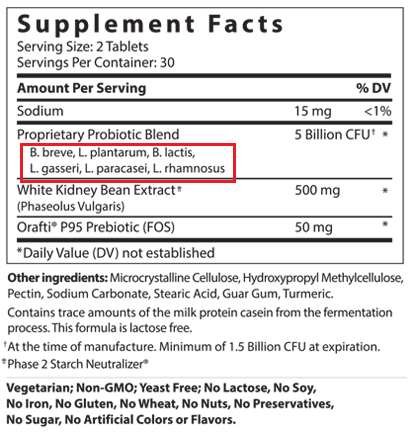5 Things You Need To Know When Choosing The Right Probiotic For Weight Loss

So you’re finally ready to buckle down and start losing weight seriously.
You head to the nearest supermarket and browse the shelves looking for a probiotic.
Rows and rows of probiotics, all basically saying variations of the same thing…
You pick one up.
“Improve gut health”…Ok, got it.
“5 billion CFU”…What’s that? Is that too much? Too little? Sounds like a lot.
“Lactobacillus…bifidobacterium”…What are those even?
You’re standing there staring at the shelves, unsure of what to do. Maybe you need to do a bit more research before you choose a probiotic supplement.
Good news! We’ve done the research for you so you can get the most effective probiotic for your money. 🙂
Read on to find out the 5 most crucial things you need to know when choosing the right probiotics for blasting away that unhealthy fat.
1. Genus and Strain
When it comes to probiotics, there are literally thousands of types of different bacteria living in your gut alone.
THOUSANDS!
That’s just crazy. Imagine having to read up on the different types before choosing the right probiotic for weight loss.
And even if you just read up on the ones that are commonly used in most probiotics, you still wouldn’t know which one is the best because…come on…every label says they’re the best.
So what do the different strains mean?
Well, for one…the most common 2 genii used in probiotics are Lactobacillus and Bifidobacterium.

If that sounds confusing, here’s all you need to know.
If the genus starts with “L” (for example, l. acidophilus), then they work in your small intestines.
If the genus starts with “B” (for example, b. lactis), then they work in the large intestines.
Simple enough? Ok, great.
Now, if I were to go into detail of all the different strains, this article will go too long. So keep reading, because if you’re interested to find out which strains have been scientifically proven to help with weight loss…I’ll share more later.
Before that though, another important thing you need to know is…
2. Number of Strains
This means how many different types of bacteria are there in a single probiotic pill/capsule.
The number ranges from 1 to even up to 20 strains.
The question is, are more necessarily better?
Most high-quality probiotics contain 5-6 different strains. So, why not 10 or even 20?
In reality, having that many strains destabilizes the probiotic. When it comes to probiotics, survival is an important factor. With that many strains in a single pill, it is difficult to determine if all strains will survive from the time they are cultivated until it reaches you for consumption.
Simply put, the more strains there are, the faster the expiry of the probiotic.
And so the optimal number of strains have been determined to be 5 or 6. Anything more, and you’ll need to be careful.
3. CFU (Colony Forming Units)
Next, CFUs are probably the most important thing to look out for.
CFU stands for colony-forming units…or in simpler terms, the number of bacteria in each serving.
These are usually numbered in the billions and can be anywhere from 5 billion to even 50 billion. Some manufacturers even go as high as 80-100 Billion!
If that number sounds impossibly large, know that your body contains about 100 trillion bacteria…which weigh about 5 pounds on their own.
That’s a lot of bacteria.
And inevitably, the question is asked. Does more mean better?
The answer is…it depends.
If you are using probiotics daily to boost your health and help with weight loss and the other positive benefits, 5 to 10 billion CFU is more than enough to get the job done.

But if you are using probiotics to heal, repair or replenish your gut (especially after going through a bout of antibiotics)…
Then you will need a higher CFU count, somewhere within the 15 to 50 billion range.
Any more than that, you should avoid. Those probiotics out there that number in the 80 to 100 billion CFU range most likely isn’t going to be beneficial and can even have negative side effects like terrible gut discomfort, gas or bloating…
Plus, you’ll likely be paying more for something you don’t need.
So if you’re replenishing your depleted gut, just stick to about 15 billion CFUs. Remember, more does not mean better.
4. Delayed-Release or Enteric-Coating

Next, your probiotics label should show that it’s delayed-release or enteric-coated.
This shouldn’t be hard to find because most (if not all) probiotics have already caught on and made sure to have this in their formula.
The reason being that some bacteria aren’t able to survive the harsh acidic conditions of your stomach, and will die…making the probiotic useless.
An enteric-coat is a protective barrier that will dissolve only in the small intestine. This allows the bacteria to survive until it reaches more habitable environments to colonize and give your body the full benefits.
Again, most probiotics should already have delayed-release. But do check if it’s not indicated on the label.
And lastly…
5. Expiration Dates
Unlike most other supplements, probiotics do have a shelf life.
That should be pretty obvious given that they are bacteria that’s actually alive and living.
That’s why they have a relatively short shelf live. For most probiotics refrigeration is recommended to slow down the rate of the living bacteria dying.
Of course, storing them in a cool, dry place is good enough. But know that at room temperature, as much as 10 to 15% of the bacteria will die per month.
That means, the longer you take to consume them, the less effective they become.
Though you shouldn’t rush to finish them as fast as possible.
Look at the manufacturing date to see how long you have until it expires, and then just follow the recommended dosage and you should be fine.
A good formula should last at least 2 years unrefrigerated unless otherwise stated.
Now that you have better knowledge of how to buy Probiotics…
Here’s the thing.
Remember in point number 1 where I talked about the different strains of bacteria?
Not all bacteria perform the same functions.
There are some which have been proven to be more effective for weight loss, while others show marginal results at best…or have nothing to do with weight loss at all.
So which strains are best for weight loss?
Well, a group of Japanese scientists came together to test the effects of a particular strain of probiotic and found that it helped their participants…who were healthy and active adults…lose up to 8.4% of belly fat in a short period of time.
Want to know what that strain is?

